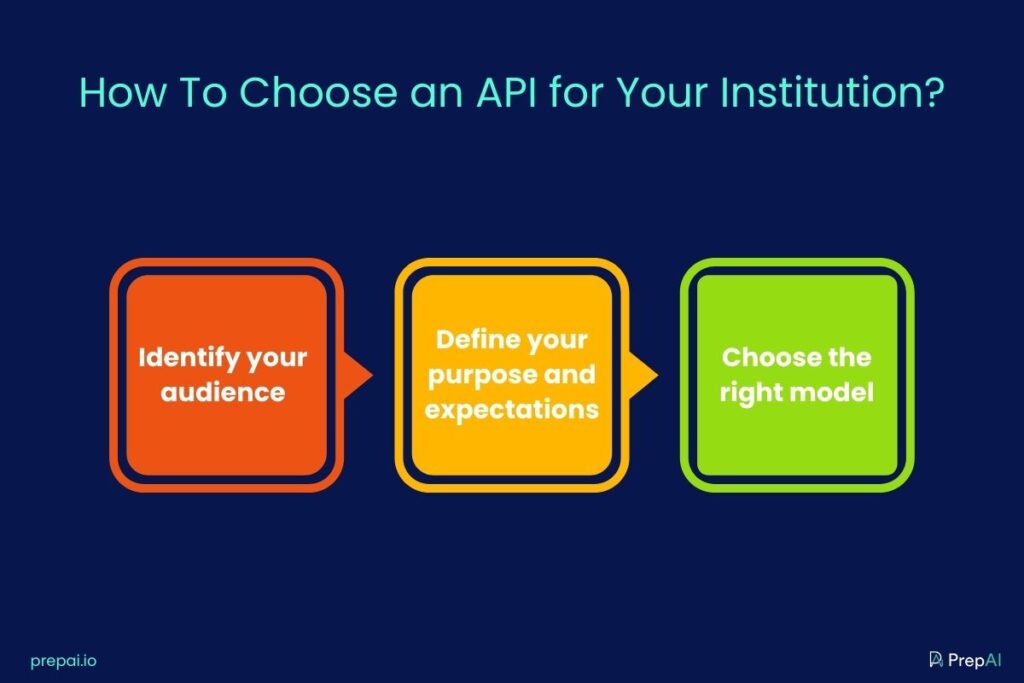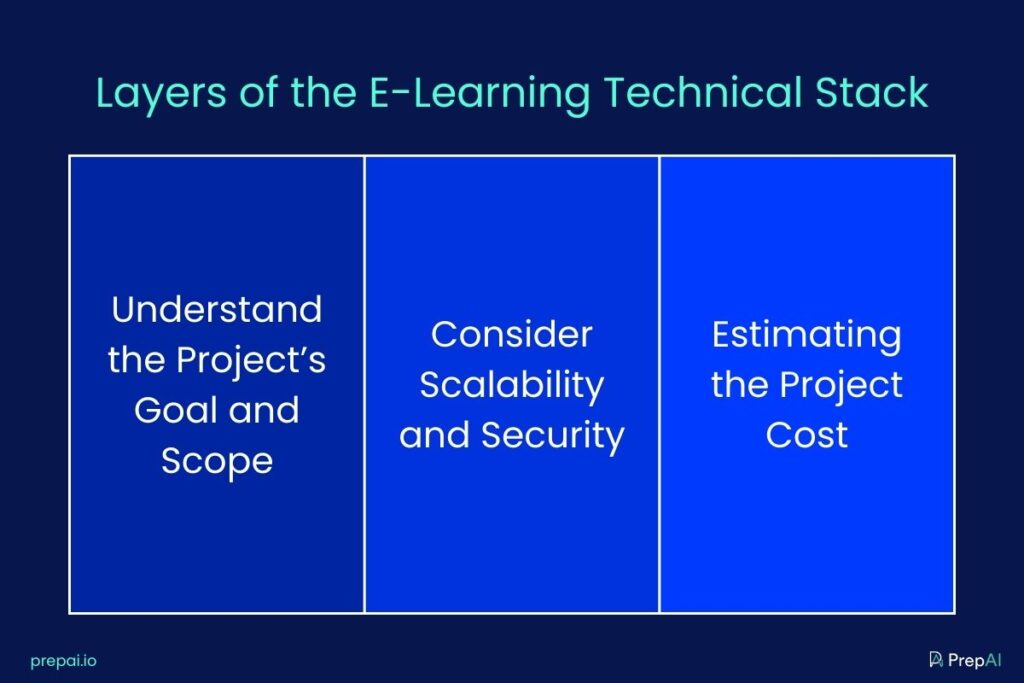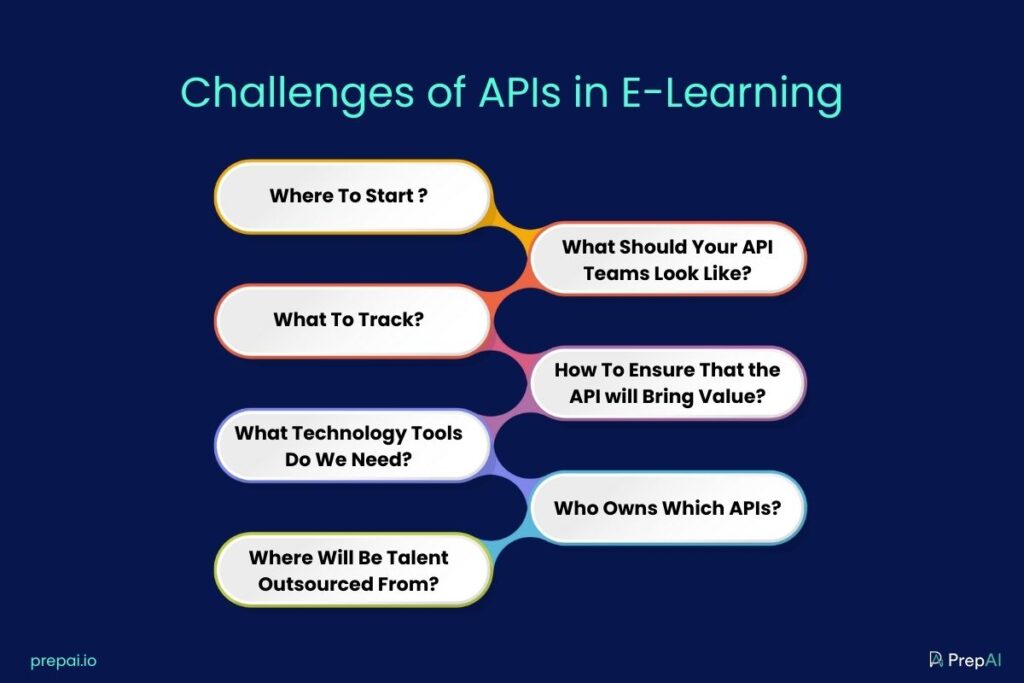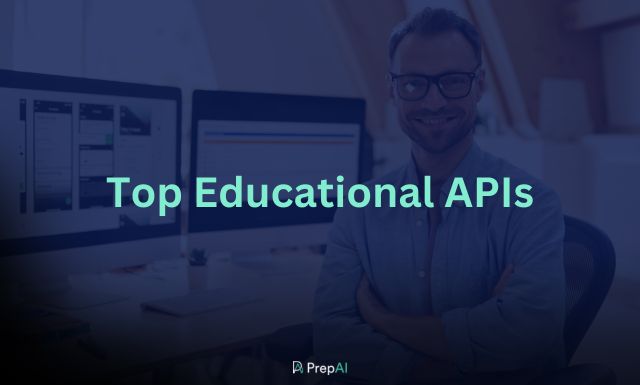Education is not limited to just memorizing information. It also includes sharing resources, tracking progress and so much more. APIs have modernized the education sector by helping in creating an engaging and stimulating learning environment.
What are APIs and what are educational APIs?
Application Program Interfaces (APIs) connect the rapid flow of information in today’s world. Educational APIs help educational institutions connect their databases with their students, researchers, and the public in general.
Importance of APIs in Education
The importance of APIs is not just limited to technological industries. APIs help businesses tap into new markets, reduce operational cost and time, optimize revenue, reduce workload, develop an engaging website, prepare questions and so much more. It plays a big role in almost every industry. Companies can grow their businesses faster than ever with APIs. They are bringing in a new wave of technical improvements helping organizations transform their business process.
Some of the advantages that APIs provide are:
Ability To Tap Into New Markets
Companies can branch into new industries and expand their revenues with APIs. Several companies have deployed API to effectively collaborate with other companies and integrate features for a more seamless experience.
Reducing Costs and Time
Traditional business strategies that involve lots of paperwork, a long sales force, etc are time-consuming and not at all cost-effective. Companies can instead access the best-of-breed components with the help of APIs and customize their solutions for a more sustainable approach. APIs can help an organization develop product strategies efficiently for the internet of devices.
Revenue Optimization
Businesses can launch APIs to:
✔ Reach out to more customers and provide better value
✔ Assist with sales and marketing activities
✔ Stimulating technical and business innovation
✔ Easily integrating applications with backend data.
All of these strategies can help businesses to optimize their revenue.
Reduce Workload
Educational institutions need to perform tasks like enrolling students, securing details, fee collection, taking attendance, distributing test marks, sharing study material, holding exams, sharing report cards with parents, etc. APIs allow you to seamlessly integrate these operations so that you don’t need to build a separate system for every function.
Developing an Engaging E-Learning Website
Suppose you want your e-learning website to have interactive features like quizzes, reward points, etc. With API, you don’t have to build a separate quizzing platform for this. The developer can just request the server regarding the requirement through an API. The API in education acts as an intermediary between the developer and the system server.
Preparing Questions
Educational institutions and training institutions can prepare question papers easily using API tools like PrepAI. Companies hiring freshers or people experienced in a different industry can prepare training modules with APIs. It reduces the cost and time investment in the training of employees and interns. Even foreign training institutions and agencies use API tools for this purpose.
How To Choose an API for Your Institution?
Choosing the correct API model for your institution is a big task. There are three main steps involved in the entire process identifying your audience, defining your purpose and expectations, and eventually choosing the right model.

The steps are explained below:
1. Identify Your Audience
The first step is to identify the three main components of an API value chain:
✔ API provider
✔ API consumer
✔ End consumer
2. Define Your Purpose and Expectations
You need to be clear about why you want to implement an API system in your organization. What are the benefits you are expecting in your business? What is the value you expect the API to bring?
3. Choose the Right Model
Once you have identified your audience and the expected benefits, you need to select the model that fits your needs.
What Are the Layers of the E-Learning Technical Stack?
Before selecting a technical stack for the LMS software development process, you have to understand the elements or layers of choosing a technological stack. The layers are understanding the project’s goal and scope, considering scalability and security, and estimating the project cost.

Understand the Project’s Goal and Scope
The scope of your educational app development project will help you understand the application size. The tools and technology requirements for large and small-size apps will be different.
Consider Scalability and Security
After the launch of an educational app, as a developer, you might need to make changes to it depending on user feedback. So you should go for tools that favor scaling. You also need to check if the programming language and framework are reliable. It can be done by conducting security assessments on server and client sites.
Estimating the Project Cost
The capital and time investment involved in the app development is a factor that decides which technology stack to utilize. There are free and subscription-based frameworks based on how advanced the features are. Also depending on whether or not you have an app development team, you have to decide on the level of complexity of the technology you want to go for.
Web-Based E-Learning Portal
Students globally demand access to e-learning portals for self-paced learning and study material. So it has become increasingly popular in educational institutions across the globe.
Virtual Learning Environment
This technical stack allows students and teachers to collaborate virtually to form an interactive learning environment. It provides tools to the teacher to organize the information delivery systematically in groups and independently.
Learning Management System
Choosing the proper LMS will depend on several factors like the company’s online training strategy, goals, and expected results. The primary function of an LMS is to provide and monitor online training. They allow you to make online training courses easily without any third-party software. You can also post learning material on it that distance learners can easily access.
Frontend Tech
The frontend of an application is the side visible to the users. It is also known as the client side. It needs to have exciting visuals and engaging features.
Backend Tech
The backend is the core of every app and website, so it is essential to choose the right technology for it. The platforms will be different for Android and iOS. You also need to consider which programming language you want to go for (Python, PHP, Ruby).
Top Educational APIs in 2024
In recent times, the e-learning sector has seen tremendous growth. Sophisticated educational APIs have been one of the key contributors to the development of the educational field.
The top 19 educational APIs are:
1. PrepAI
PrepAI is an ed tech tool or API for schools that uses artificial intelligence to create tests. It improves the accuracy levels and time requirements for test preparation. It is one of the best APIs in education.
Pros:
✔ No human bias is involved in correction.
✔ Minimizes operational cost and time.
✔ Assess your students’ level of understanding of concepts.
✔ Maintaining consistency and high quality in the question paper.
✔ Auto updating the assessments.
✔ Auto updating the syllabus and learning content.
✔ User friendly and highly interactive.
Cons:
✔ Does not support mathematical equations, chemical reactions, numerals, tables, and diagrams while generating questions.
✔ Supports content only in the English language.
2. Google Classroom APIs
Teachers can conduct and grade assignments with this user-friendly API.
Pros:
✔ Free training and learning opportunities
✔ Google Drive and other tools are integrated.
Cons:
✔ No automated updates
✔ Does not allow access from multiple domains
✔ No automated quizzes and tests.
3. API for WizIQ Virtual Classroom
This API provides interactive online learning resources like payment collection, online classroom, admission, etc.
Pros:
✔ Feature for holding live classes for multiple users.
✔ Easy posting and handling of learning content.
Cons
✔ Lack of synchronization
✔ Problems with a chatbot
✔ Slow loading times due to the poor server.
4. Quizlet Flashcards API
This is one of the public APIs for learning that gives you access to more than 2 million flashcards to upload notes on every subject.
Pros:
✔ Enable enhanced teamwork and collaboration
✔ Easily give reviews to students
Cons:
✔ Several distracting ads
✔ Can be easily used for cheating
✔ Sometimes the information can be incorrect
5. Khan Academy API
This online resource provides free educational tools like online videos of multiple subjects.
Pros:
✔ All the information is categorized into a playlist.
✔ Provide badge award details on the exercise dashboard.
Cons:
✔ No collaborative features
✔ Restricted to video mode of learning
✔ Less interactive
6. OpenEd REST API
This API leverages machine learning to find out compatible teaching resources with learning principles.
Pros:
✔ It provides information about resource search, requirements, and participation.
✔ Content producers can submit high-quality K-12 resources to OpenEd through the OpenEd API.
Cons:
✔ It is just a generic middle layer, not specific enough to drive a uniform API by itself.
✔ The client keeps the state instead of the server.
7. Scorm API
This API enables different online learning CMS and learning management system API platforms to seamlessly function together.
Pros:
✔ The eLearning content is compatible with multiple LMS solutions.
✔ It protects the makers of LMS solutions from the future since they have to face no problems in uploading, managing, and tracking different learning content.
Cons:
✔ Not mobile friendly
✔ Lack of intelligent reporting
✔ The interface can feel cumbersome at times.
8. Vimeo
This API allows developers to create a system for managing video lessons and student submissions within the LMS application.
Pros:
✔ You can easily streamline the process of uploading a video, getting metadata of the video, organizing all the video material, editing the video’s privacy settings, etc.
✔ The LMS integration with the Vimeo API is fast.
Cons:
✔ Sometimes there are issues related to uploading, embedding, and playing content.
✔ The content presented on the API is not well organized.
✔ Starting price does not include the setup fee.
9. Veracity LRS API
Developers can create reporting dashboards and custom visualizations with this API.
Pros:
✔ You can automate and streamline all the manual processes.
✔ You can maintain records of learning data of all users with the LRS which is an extension of the LMS.
Cons:
✔ It is not user-friendly.
✔ Installation and configuration are tough.
✔ Building the LRS is not easy.
10. Microsoft Graph Educational API
You can administer specific Office 365 tools and data along with classrooms, tasks, entries, courses, and enrollments with this API.
Pros:
✔ You can use this API additionally for school roster management.
✔ You can easily create class assignments in an assignments tab.
Cons:
✔ There are a few limitations in the attachment API with filters.
✔ You cannot put date range filters.
✔ The filters don’t work with attachments.
11. Schoology
It is a learning management system and a social learning app with which you can develop and distribute instructional material.
Pros:
✔ Programmers can monitor and reuse data of users and students for other websites.
✔ You can easily keep track of assignments, meetings, and readings.
Cons:
✔ Is not compatible with Microsoft Office.
✔ difficult for students to find the materials.
✔ Difficult for students to turn in assignments and for teachers to post assignments.
12. Blackboard
It is an API that helps business, K-12, government, and higher education educators to interact with students.
Pros:
✔ Enables programmers to control ads, course subscriptions, lesson material, course grades, sources of data, etc.
✔ Enables users to create content for the course, submit targeted updates, hold a conversation and utilize analytics to track the students’ progress.
Cons:
✔ The platform lacks stability and a feature set.
✔ The site is clunky. The drag-and-drop operations require multiple clicks.
✔ The options for customization are very limited.
13. Assembly Platform API
This API makes a framework for collecting data for educational purposes.
Pros:
✔ Integrates the data systems and information with other educational tools.
Cons:
✔ Machine architecture dependent.
14. Poodll API
This API allows users to record themselves and upload the recordings on the LMS application.
Pros:
✔ Uploaded content is formatted, stored, and ready to be reviewed.
✔ Teachers can readily track the progress of students.
Cons:
✔ The recording quality can be poor.
✔ Study material isn’t already available.
15. Badgr API
This API allows the incorporation gamification process in the LMS application.
Pros:
✔ It is free and open source.
✔ Users can track progress and organize users learning paths into neat pathways.
Cons:
✔ The platform comes with a fair amount of automation which is not easy to use.
✔ Pathways might be complicated at times.
16. ShepHertz App42 Cloud API
This API allows developers to integrate leaderboards within their LMS applications.
Pros:
✔ Allows developers to create gamification features such as top ranking, and social ranking.
✔ This API also allows one to extract the average or highest score for users for a game and give rewards.
Cons:
✔ Supports only English
17. H5P
This API allows the creation of interactive and rich e-learning content on HTML5.
Pros:
✔ It allows even non-designers to build course content.
✔ It is supported and can be integrated with LMS systems such as Brightspace, Canvas, Drupal, Blackboard, Moodle, WordPress, etc.
Cons:
✔ Not versatile like the other paid tools.
✔ No option to import power points
✔ No survey tool or customization.
18. Knewton
This API allows developers to retrieve Knewton’s data to meet the learning demands of the students.
Pros:
✔ There are customized courses in SAT, GMAT, LSAT, etc.
Cons:
✔ Some of the learning content is not satisfactory.
19. EnGrade
This API allows developers to merge class management tools and fit in the students.
Pros:
✔ There are several classroom tools, such as a grade book, secure messaging, homework calendar, online quizzes, and flashcards.
✔ Millions of teachers, students, administrators, etc, use it.
Cons:
✔ The API functioning is sometimes slow.
✔ Sometimes students face difficulty accessing the quizzes, homework, etc.
The Challenges of APIs in E-Learning
Here are some of the challenges that are faced in API implementation:

Where To Start With the API?
The API program is so flexible that it can be used for any application. So as an organization you need to identify which application can enable crucial customer-facing applications. The API needs to be developed based on the business strategy, implementation ability, modernization impact, etc.
What Should Your API Teams Look Like?
The core strategy to develop the correct operational model is for teams with the proper skill set and a proper organizational structure. The IT team needs to align the leadership around the API development.
The three models to choose from are:
✔ Centralized
✔ Decentralized
✔ Hybrid
What To Track?
To measure API performance, companies can use multiple metrics. Companies need to determine the metrics that will be used to assess the performance of the API.
How To Ensure That the API will Bring Business Value?
You need to find out which APIs will directly serve the business and which of them will serve as technical enablers. The IT staff needs to determine which API will deliver the customer experience.
What Technology Tools Do We Need?
The IT team of an organization needs to decide the right application-development framework/platform for building APIs. The team then needs to establish data formats and the design of the API reference architecture.
Who Owns Which APIs?
Depending on whether your organization has already defined its digital strategy, the API needs to be built accordingly. The API should meet specific milestones.
Where Will Be Talent Outsourced From?
The companies need to either hire an in-house team or a freelancer to build the API. It is not dependent on technology strategy alone.
How Have APIs Transformed the E-Learning and Training Industries?
Since the pandemic, educational institutions were quick to implement remote learning. Student information systems (SIS) and learning management systems (LMS) were adopted rapidly. APIs have helped educators track students by integrating a variety of systems. The Learning Management System has been the core of the training of the students and the workforce.
In regulatory-heavy industries like banking, healthcare, and medical, APIs have become a necessity in the training of employees. The education sector has shifted to a more user-centric approach. The students, teachers, and workforce members demand a more personalized experience. So LMS systems combine videos on learning sites with self-authored materials to make learning more unique.
Conclusion
The future of education and employment centers is heavily dependent on APIs. Remote learning and assessment will be a common trend in the future, and institutions need to rapidly implement it.



